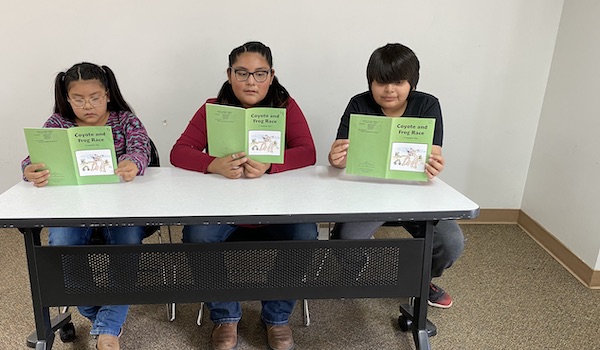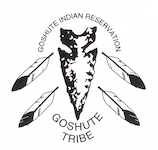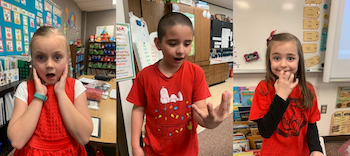SUBJECTS
GRADE
Show Results
Coyote & Frog Race: A Goshute Tale

Lesson Summary
Explore the Goshute tale “Coyote and Frog Race” with dramatic storytelling, and improvisation.
Learn about the 5 elements of a story by answering WHO, WHAT, WHEN, WHERE, and HOW questions.
Lesson Plan and Procedure
Lesson Key Facts
- Grade(s): 2, 3, 4
- Subject(s): Drama, English Language Arts, Social Studies, Native American, Tribe Approved
- Duration of lesson: 2 sessions, 40 minutes each
- Author(s): Charlene Pete and Yvette Ward May

The Confederated Tribes of the Goshute Reservation’s Business Council selected this lesson content in answer to the question, “What would you like the students of Utah to know about you?” Charlene Pete, the CTGR Educator Director, and Clell Pete, the 2022 Business Council Vice Chair, represented the Confederated Tribes of the Goshute in crafting the lesson to provide expertise, accuracy, and authenticity. The lesson received approval for publication with the tribal seal by the 2023 CTGR Business Council, whose headquarters are in Ibapah, Utah.
Before teaching this lesson, please explain to your students that while there are many Native tribes in the United States, this lesson specifically focuses on experiences of the Confederated Tribes of the Goshute and does not represent other Indigenous groups, unless specifically identified.
Important note: To honor a Goshute coyote storytelling tradition, only share this lesson and story during the winter months, or cold weather (October to beginning of Spring).
DAY 1:
Lesson:

Use: Day 1 & 2: Lesson and Activity Guide.pdf
Upload: Coyote and Frog Race Lesson Slides: A Goshute Tale, pptx (Slides 1-33)
DAY 2:
Determine and prep a circle performance space in your classroom.
Lesson:
Use: DAY 1 & DAY 2 Lesson and Activities
Upload: Coyote and Frog Race Lesson Slides: A Goshute Tale, pptx (Slides #34-41)
SCRIPT: Coyote and Frog Race.

Learning Objectives
Become acquainted with aspects of The Confederated Tribes of the Goshute Reservation’ culture, land, and heritage.
Explore a Goshute Tale, “Coyote and Frog Race.”
Learn the 5 elements of storytelling: Plot, Setting, Character, Conflict/Problem, and Conclusion
Develop dramatic skills as improvisational actors, and practice audience etiquette.
Utah State Board of Education Standards
This lesson can be used to meet standards in many grades and subject areas. We will highlight one grade’s standards to give an example of application.
Grade 2 English Language Arts
Standard 2.R.5: Ask and answer questions such as who, what, where, when, why, and how to demonstrate understanding of key details in a text. (RL & RI)
Standard 2.R.6: Read a variety of texts including those from diverse cultures, retell the narrative (RL) or informational text (RI) according to the text structure including the main idea.
Standard 2.R.7: Describe how characters respond to major events and challenges. (RL)
Standard 2.R.12: Demonstrate understanding of story elements and/or topics by applying information gained from illustrations or text features. (RL & RI)
Grade 2 Drama
Standard 2.T.CR.1: Develop imagination to create artistic ideas and work.
Standard 2.T.CR.3: Create a scene or play with a beginning, middle, and end.
Standard 2.T.CR.4: Define roles and responsibilities and participate in group decision making.
Standard 2.T.CR.5: Create character through physical movement, gesture, sound and/or speech and facial expression based on stories or through improvisation.
Standard 2.T.P.1: Identify the character, setting, and essential events (plot) in a story that make up the dramatic structure, and use choices to shape believable and sustainable drama/theatre work.
Standard 2.T.P.2: Demonstrate the ability to work effectively alone and cooperatively, with a partner or in an ensemble.
Standard 2.T.P.3: Observe, listen, and respond in character to other actors.
Standard 2.T.P.4: Use body to communicate meaning through space, shape, energy, and gesture.
Standard 2.T.P. 5: Use voice to communicate meaning through volume, pitch, tone, rate, and clarity.
Standard 2.T.P.6: Use imagination to support artistic choices.
Standard 2.T.P.8: Develop audience awareness in dramatic play and experiences.
Standard 2.T.P.9: Share dramatic play and guided drama experiences within the classroom or with invited guests.
Strand: RESPOND (2.T.R.)
Students will perceive and analyze artistic work and process. They will interpret intent and meaning, and apply criteria to evaluate artistic work and process (Standards 2.T.R.1–4).Standard 2.T.R.1: Demonstrate audience skills of observing attentively and responding appropriately.
Standard 2.T.R.2: Share personal responses about classroom dramatizations and performances.
Standard 2.T.R.3: Identify what drama is and how it happens.
Standard 2.T.R.4: Give and accept constructive feedback; and use selective criteria to evaluate what is seen, heard, and understood in dramatizations.
Strand: CONNECT (2.T.CO.)
Students will synthesize and relate knowledge from personal and collaborative experience to make and receive art. They will relate artistic ideas and works with societal, cultural, and historical context to deepen understanding (Standards 2.T.CO.1–2).Standard 2.T.CO.1: Identify similarities between story elements and personal experiences in dramatic play or guided drama experiences.
Standard 2.T.CO.2: Read, listen to, and tell stories from a variety of cultures, genres and styles, and identify connections to other content areas in dramatic play and guided drama experiences.
Grade 2 Social Studies
Standard 2.2.7: On a map of the world, locate where their families or other families in the community historically came from. With support, curate and share information about the traditional food, cultural customs, recreation, religion, and music of that country and/or region.
Equipment and Materials Needed
Print a copy of Day 1 & Day 2 Lesson and Activities.
Read through the entire lesson and preview the PowerPoint: Coyote and Frog Race Lesson Slides
Use a big white board for the class discussion, slide #33.
Familiarize yourself with the audio pronunciations provided for the following Goshute words. Click on the blue parentheses to connect and play audio link.
Coyote: isaipappeh (e-gyp-uh)
Frog: wakko (wah-go)
The People: Newe (Noo-wah)
Goshute: Gosiutta (Go-see-uta)
Print two copies of the Script: Coyote and Frog Race. Keep one for yourself and cut the other into numbered strips for your students. (Print the student copy on cardstock.)
Bring a real feather or print a picture of a feather.
Print Student book: Coyote and Frog Race.pdf (optional).
In preparation for Day 2: Determine and prep a circle performance space in your classroom.
Familiarize yourself with new vocubulary and definitions for teaching the lesson, as needed:
Newe: (Noo-wuh) the name the Goshute people use to refer to themselves. It means “the people.”
Goshute: Goshute means “people of the desert.” Since time immemorial, the Goshute have inhabited the Great Basin Desert in Western Utah and Eastern Nevada. Many other words have been associated with the Goshute people due to the language barrier at the time of white settlement. Words like Goship, Gutsipiuti, Kutsipiuti, Go-shoot, and Go-sh-yuta were created because white settlers could not understand the traditional word for Goshute, Gosiutta. Gosiutta (Go-see-uta) is the proper, traditional way to say the Goshute name today. As a greeting, the Goshute refer to themselves as the Gosiutta Newe.
sovereign nation: A sovereign nation is a nation that has one centralized government that has the power to govern a specific geographic area. Under the definition set by international law, a sovereign nation has a defined territory with just one government. There are eight Native American Sovereign Nations in Utah.
oral tradition: Oral tradition includes the passing down of stories, beliefs, etc., that a group of people share by telling and talking to each other.
tribe: A group of people, families, or villages that share the same language, social customs, and ancestors. A tribe often lives and works together in a shared geographical area. A tribe often has a common culture, dialect, and religion.
band: A small group, often a family. The Goshute understood that small family groups enabled survival in western Utah because of the harsh desert climate. The Goshute lived in informal band groups with loosely defined leadership. Often leadership formation was oriented to a particular activity such as a communal hunt. Familial leaders were typically fathers, grandfathers, uncles, or other male relatives.
The Confederated Tribes of the Goshute: (See Confederated Tribes of the Goshutes | Utah Division of Indian Affairs)
reservation: A Federal Indian Reservation is an area of land reserved for a tribe or tribal homeland.
indigenous: Indigenous means the first people who lived in any region.
drama: A drama is a type of story acted out before an audience, often in a theater. Dramas are commonly called plays.
improvisation: To speak or perform without preparing ahead of time.
tale: These are stories from a culture’s oral traditions meant to share values and/or explain something in the natural world or about human nature. Tales are often about ordinary people and, like fables, can include talking animals. Sometimes tales contain a wise life lesson.
personification: Personification is when human qualities are given to something that isn't human. Because the characters in the storytelling circle are animals, plants, and non-living objects with human character traits, this might be a good concept to teach.
Additional Resources
This lesson is supported by the National Endowment of the Arts and the Utah Division of Arts & Museums.
Coyote and Frog, a Goshute Tale written by LeeAnn Parker and Curtis Yanito
Drama Game for kids. Mr Chop's Sweet Shop. Facial and vocal warm up.
For added fun watch one of the videos below to learn and teach sign language for the words who, what, when, where, how, and why.
ASL WH Questions (who, what, when, where, why...) (Play to 1:09)
How to Sign - Who - What - When - Where - Sign Language - ASL
For the word “how”, watch this video from 6:06-6:15
https://indian.utah.gov/confederated-tribes-of-the-goshutes/
http://www.supercoloring.com/sites/default/files/fif/pdf/2018/08/coyote-mask-outline-paper-craft.pdf
Image References
Image 1: Cover photo of students from Ibapah, courtesy of Charlene Pete (CTGR Education Director 2022).
Images 2-3: Additional photos by Brenda Beyal and Emily Soderborg, Cherry Creek Elementary.
(Creative commons photo credits are included in the speaker’s notes in the slide presentation.)
© Brigham Young University and Confederated Tribes of the Goshute Reservation

www.education.byu.edu/arts/lessons
 Download
Download